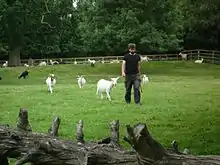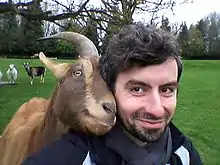Goats as pets
Overview


Goats are sometimes kept as pets because of their ability to form close bonds with their owners.[1] Goats are herd animals by nature and typically prefer the company of other goats, but because of their herd mentality, they will follow their owner and form close bonds with them, hence their continuing popularity.[2]
Ideally, one requires a minimum 20 square metres (200 sq ft) or more for every goat.[3]
Although goats are relatively hardy animals, domestic goats are usually provided with shelter from wind and rain. Hay is a necessary food source and a manger keeps it off the ground where they might urinate and defecate upon it. Occasionally owners provide a salt lick is also a wise adjunct so as to provide them with essential minerals. Being cloven-hoofed animals, they also need their feet to be examined from time to time and to be trimmed if necessary, since some breeds evolved in areas where hard rocky surfaces continually wear down their hoofs, whereas on soft land pasture their hoofs may overgrow. Such overgrowth can lead to problems requiring veterinary visits.
Owners usually provide robust fencing, as goats rub up against things in order to scratch themselves and can destroy low-quality fencing, only to then escape through the small gaps that they create.
Goats are carriers for several diseases that can pass to humans such as leptospirosis, Q fever, brucellosis, and toxoplasmosis.[4]
Feeding a goat
Goats are more similar to deer with regard to nutrition than they are to sheep or cattle, which eat a large amount of grass. Goats ideally should not have a diet of only eating fresh grass. To keep a goat happy and healthy, they must be fed a wide range of nutrients that have different sources and minerals. These can include things like: hay, chaffhaye, grain feed or pelleted grain mix, loose minerals, and sometimes even kitchen and garden scraps (in moderation).[5] Goats may prefer to feed on pellets and coarse flour but it is important to know that animals generally either inherit certain feeding preferences or learn them after birth.[6]
Behavior and temperament
Goats are naturally a herd animal and require to live at least with one or more of their kind as they are very social animals. Because they are considered 'social' animals, they enjoy human interaction.
Good environments for goats include rural areas, farms, or homes with acreage because sufficient space (such as a yard or pasture) is necessary for their comfort and well-being. All of this depends on the breed and the number of goats housed in one area. If you reside in a city, bylaws can keep you from housing goats as they are considered an agricultural species.[7]
Goats can, in general, get along with most other livestock, although this varies between individuals. Goats have been known to accidentally trample small poultry such as turkeys and geese, so perches where these birds can roost out of reach of the goats is essential in avoiding such incidents. Some larger livestock like donkeys can be aggressive towards goats if they're not acclimated to them, or if the individuals have aggressive temperaments.[8]
Male goats tend to be more dominant according to age, when they reach the age of six years old their strength and dominance can decline. The horns and body size are just as important as their age when determining a dominant goat. Goats tend to display their dominance by lowering their head and pointing their horns at the subordinate animal. Animals tend to test their dominance by locking horns repeatedly until one of them wins.[9] When they are in season, the male goat will mate with the females and he also protects the herd from any predators. The dominant male goat tends to keep his position until he dies or until he is challenged and defeated by another buck.[10]
See also
References
- Nawroth, Christian; Brett, Jemma; McElligott, Alan (5 July 2016), "Goats display audience-dependent human-directed gazing behaviour in a problem-solving task", Biology Letters, 12 (7): 20160283, doi:10.1098/rsbl.2016.0283, PMC 4971169, PMID 27381884
- Deamer, Kacey (July 15, 2016), Man's New Best Friend Is a Goat?, Live Science
- Kimberling, D.V.M., Cleon. "Introductory information on pet goats". Goatworld. Retrieved August 19, 2016.
- "What are some diseases goats can transmit to humans? - eXtension". articles.extension.org. 2010-08-27. Retrieved 2019-06-02.
- "Learn How to Feed and Tend Goats on the Small Farm". The Spruce. Retrieved 2020-04-19.
- Morand-Fehr, P. (2003-09-01). "Dietary choices of goats at the trough". Small Ruminant Research. Advanced research on nutrition of sheep and goats, with special reference to pasture and rangeland use. 49 (3): 231–239. doi:10.1016/S0921-4488(03)00141-X. ISSN 0921-4488.
- "Pet Goats Will Need Room to Roam". The Spruce Pets. Retrieved 2020-04-19.
- . The Open Sanctuary Project https://opensanctuary.org/article/how-goats-get-along-with-other-species/.
{{cite web}}: Missing or empty|title=(help) - "Goat Behaviour". www.acsedu.co.uk. Retrieved 2020-04-19.
- "Goat Behaviour". www.acsedu.co.uk. Retrieved 2020-04-19.